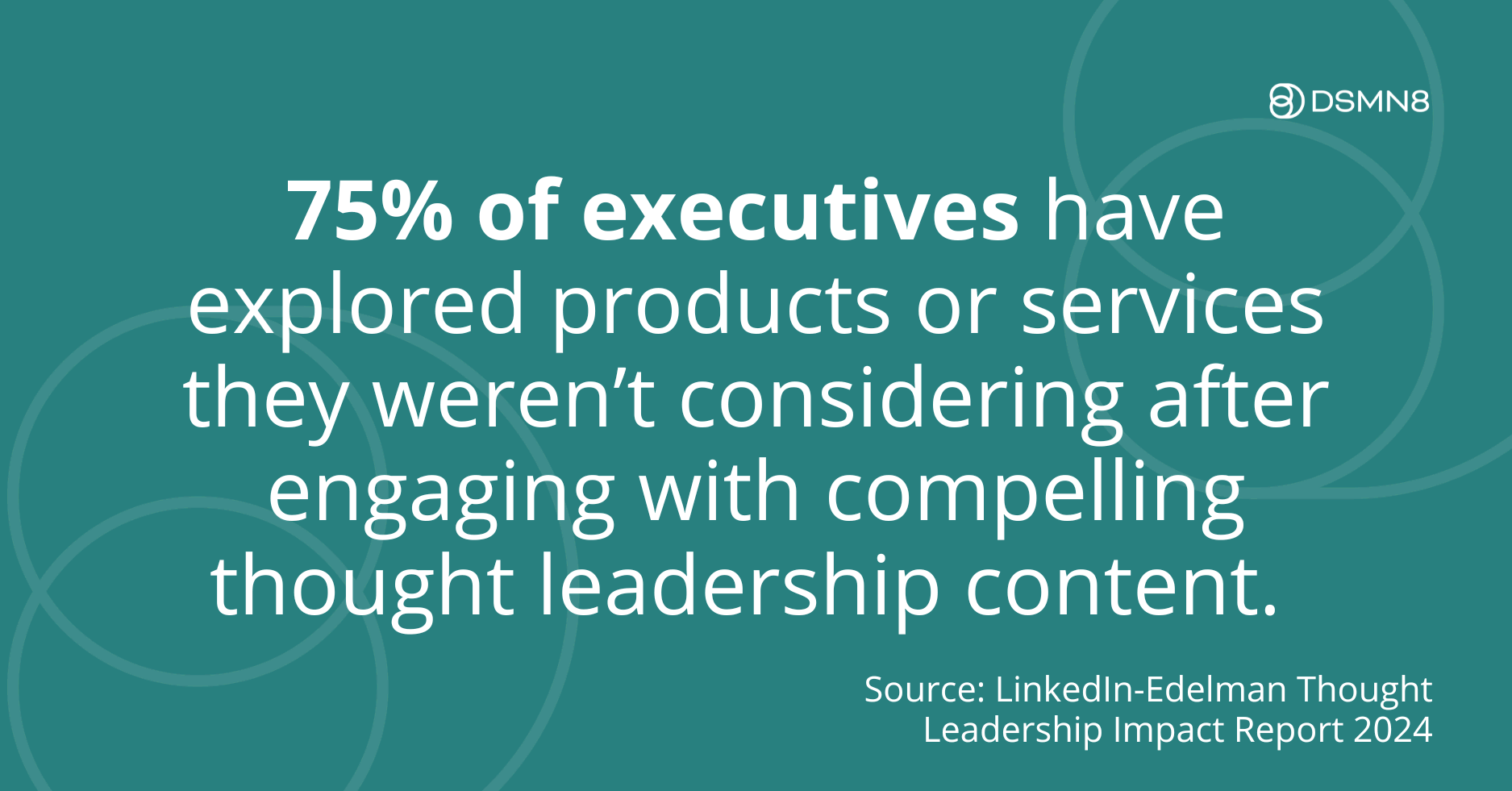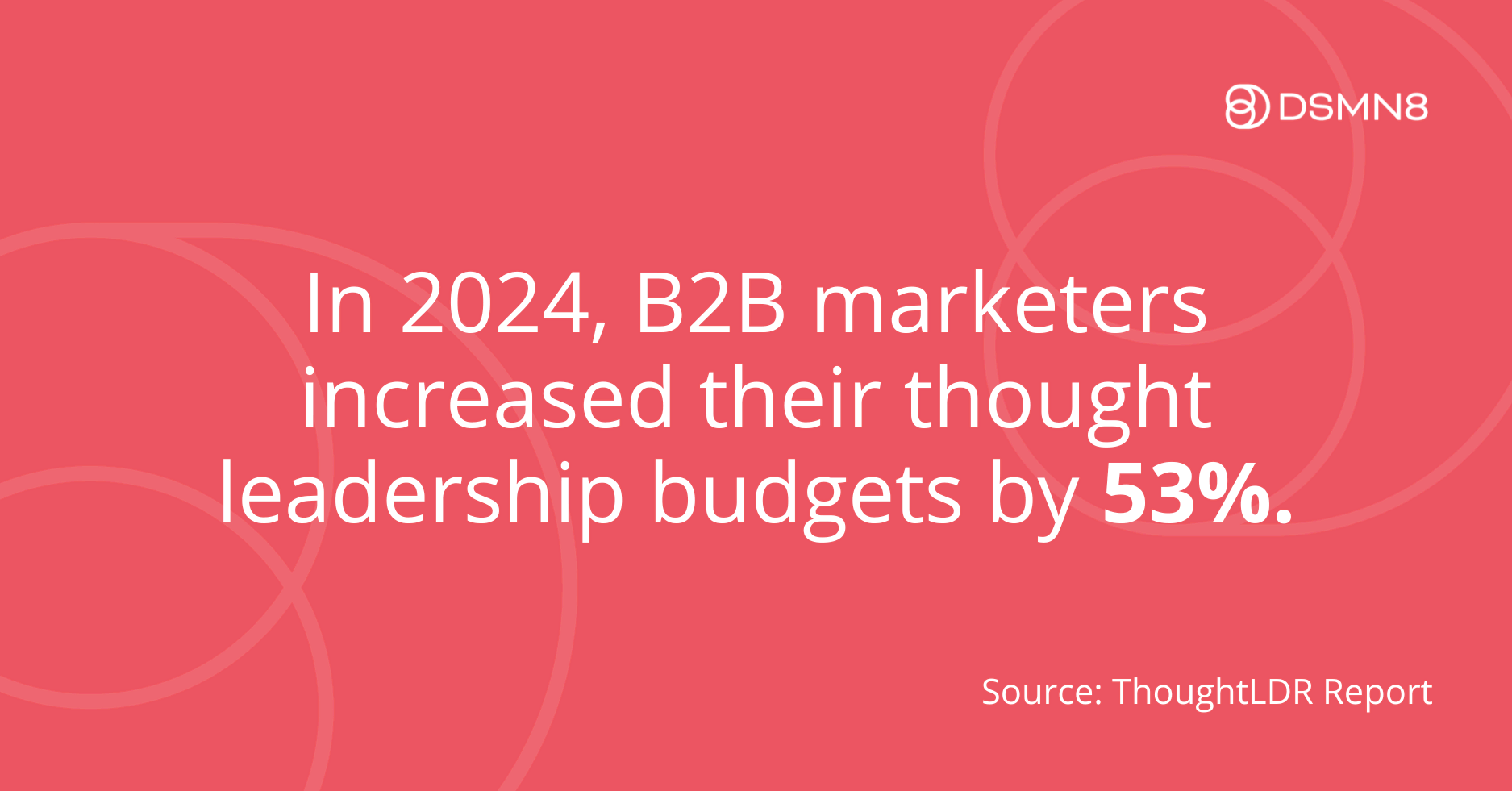
Thought leadership is one of the most effective ways to build trust, influence buyers, and position your brand as an authority.
But you don’t have to take that at face value. These thought leadership statistics highlight exactly how impactful well-crafted content can be.
If you’re creating or refining a thought leadership strategy, understanding the data behind it is essential for gaining executive buy-in. Here are 18 statistics that show why thought leadership remains a powerful tool for success on social media in 2025.
What is Thought Leadership?
The term thought leadership was coined in 1994 by Joel Kurtzman, editor-in-chief of Strategy+Business magazine. A thought leader is someone recognised by peers, customers, and industry experts for their deep understanding of their industry, customer needs, and the wider market.
True thought leaders offer original ideas, unique perspectives, and fresh insights that inform, inspire, and influence others. It’s not just about sharing knowledge, it’s about providing value through expertise and forward-thinking viewpoints. However, it’s also important to consider who gets to share those viewpoints. In fields like STEM gender gap remains a pressing issue, limiting diverse representation in thought leadership and innovation.

The Growing Need for Thought Leadership
With longer buying cycles and increasing complexity in decision-making, thought leadership has become essential for guiding and influencing both external and internal audiences.
-
90% of B2B buyers experienced longer purchase cycles in 2024, increasing the demand for insightful content that supports complex decisions. (Edelman-LinkedIn Thought Leadership Impact Report, 2024).
-
69% of professionals agree that thought leadership is an effective internal communication tool for engaging colleagues and employees. (FT Longitude Insights).
-
76% say thought leadership content helps them make better business decisions. (FT Longitude Insights).

The Impact of Thought Leadership Content
High-quality thought leadership doesn’t just build awareness, it drives real business outcomes.
From influencing buying decisions to strengthening brand trust, investing in thought leadership can be a game-changer. However, it’s important to note that poor content can have the opposite effect.
-
60% of decision-makers are willing to pay a premium to work with companies that demonstrate strong thought leadership. (Edelman-LinkedIn Thought Leadership Impact Report, 2024).
-
75% of executives have explored products or services they weren’t considering after engaging with compelling thought leadership content. (Edelman-LinkedIn Thought Leadership Impact Report, 2024).
-
53% of buyers say thought leadership has directly influenced a purchasing decision. (Clearly PR, 2024).
-
Thought leadership drives $100 billion in annual corporate spending. (The MX Group).
-
78% agree that intelligent thought leadership increases trust and makes them more likely to engage with a company in future. (FT Longitude Insights).
-
But 73% warn that poor-quality thought leadership can harm a company’s reputation. (FT Longitude Insights).
-
3 in 4 job candidates prefer companies with visible leadership teams that regularly share expertise and demonstrate innovation. (FT Longitude Insights).
-
71% of marketers cited increased website traffic as the top benefit of thought leadership. (SurveyMonkey Thought Leadership Report, 2020).
How active are your executives on LinkedIn, and what impact does this have?
Get a free executive influence competitor analysis review to find out!

How Thought Leadership is Consumed
Thought leadership content plays a key role in daily professional life, influencing not just buying decisions but also hiring practices and industry perception.
-
24% of senior leaders consume thought leadership content daily, while 31% engage with it weekly. (Clearly PR, 2024)
-
54% of decision-makers spend at least an hour per week consuming thought leadership content. (LinkedIn-Edelman Research).
-
82% of recruiters say a candidate’s thought leadership presence is more important now than it was before the pandemic. (ThoughtLDR Report).
-
77% agree that being a thought leader doesn’t require a large social media following. (SurveyMonkey Thought Leadership Report, 2020). DSMN8’s 500,000 employee LinkedIn posts study backs this up, showing that those with 5,000-10,000 connections often outperform influencers with 10,000+ when it comes to engagement.
Ready to get your employees actively sharing thought leadership on LinkedIn? Book a Demo with DSMN8, the #1 user-rated employee advocacy platform.

Is Thought Leadership a Priority?
Increasing investment and focus from marketers show that thought leadership is no longer optional — it’s a key part of brand and growth strategies.
-
B2B marketers increased thought leadership budgets by 53% in 2024, reflecting its rising importance. (Thought LDR Report).
-
High-growth SaaS startups allocate up to $140,000 annually to thought leadership SEO efforts (FirstPageSage 2025).
-
66% of marketers considered thought leadership a top priority as early as 2020. (SurveyMonkey Thought Leadership Report, 2020).
Key Takeaways
These statistics highlight the growing importance of thought leadership in building trust, influencing decisions, and driving business growth.
As buying cycles lengthen and audiences seek authentic insights, high-quality thought leadership has become a critical tool for external influence, internal alignment, and employer branding.
Investing in strategic, well-crafted thought leadership content is essential for companies that want to remain competitive and credible in 2025 and beyond.
Additional Resources
Looking to amplify your thought leadership strategy?
Your employees are your greatest asset. With DSMN8, you can empower your team to share expert content, boost brand visibility, and build trust through authentic voices.
Discover how employee advocacy can extend the reach of your thought leadership and drive real business results.
👉 Book a demo with DSMN8 and see how easy it is to turn your employees into industry influencers.
Jody Leon
VP of Marketing at DSMN8. With over 20 years of experience in marketing and advertising, Jody leads the DSMN8 marketing team, covering brand, demand, and product marketing.



